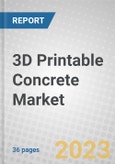The report provides an overview of the global 3D printable concrete market and analyzes market trends. The base year considered for analyses is 2022, while the market estimates and forecasts are given from 2023 to 2028. Revenue forecasts for this period are subdivided based on building type and region. The market estimates are only provided in terms of revenue, USD million.
For preparing accurate quantitative estimates for 2022, we have only included the revenue generated from 3D printable concrete sales within buildings that are greater than 10 meters square or 110 square feet and are situated outdoors. In addition, the walls must have been fully 3D printed. However, qualitative insights and analyses entail all kinds of structures and buildings 3D printed with concrete.
Report includes
- Overview and an up-to-date analysis of the global markets for 3D concrete printing (3DCP)
- Analyses of the global market trends, with historical market revenue data (sales figures) for 2022, estimates for 2023, and projections of compound annual growth rates (CAGRs) through 2028
- Estimate of the actual market size and revenue forecast for the 3DCP market in USD millions, and corresponding market share analysis based on the type of printing, technique, end-use sector and geographic region
- In-depth information (facts and figures) pertaining to the market’s drivers, challenges, opportunities and prospects; the technologies and regulatory scenarios; and the impact of macroeconomic variables on the 3DCP market
- An industry value chain analysis providing a systematic study of key intermediaries involved, with emphasis on manufacturers, raw materials suppliers, 3DCP service providers and the major types of end users
- A look at ESG developments in 3DCP, with emphasis on the importance of ESG, consumer attitudes, risks and opportunities assessment, and ESG practices followed by companies
- An overview of the major vendors in the global 3DCP market, along with an analysis of the structure of the industry, including market shares and recent mergers and acquisitions (M&A) activity
- Patent analysis covering recent patents awarded across each major category
Table of Contents
Companies Mentioned
- Cobod International A/S
- Cybe Construction
- Heidelberg Materials AG
- Holcim
- Icon Technology, Inc.
- Laticrete International, Inc.
- Sika AG
- Xtree
- Yingchuang Building Technique (Shanghai) Co. Ltd. (Winsun)








